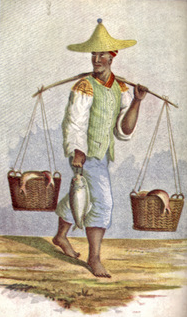By virtue of the town still being so small less than three decades after its establishment, it was still possible to print a comprehensive list of all its officials and residents. The List of Town Officials was published in 1843 whereas that of all Town Residents was published in 1849.
What do they reveal about the character of these people and the occupations that they held?
Main picture: Port Elizabeth in 1840 with its short-lived first jetty
List of Town Officials in 1843
What is of interest apart from some of the salaries which are mentioned, are the types of jobs held such as Distributor of Stamps and Tidewaiter.
One can also speculate what Mr. Biggar would have earned as Postmaster when Mrs Mary Biggar, the Postmistress, was earning £40 p.a. My guess would be a whole lot more. A Tidewaiter was a customs officer who boarded ships on their arrival to enforce the customs regulations.
















Residents of 1849
Of the 362 residents listed, it should be noted that females or minors clearly did not count and hence were not listed unless they were either widowed or they had some form of occupation such as being a milliner or a school teacher. Furthermore of this number, only 262 list some form of vocation.
In order to understand the nature of the inhabitants jobs, I have categorised them into skill levels and overall type of job. Based upon this analysis, the following picture emerges.

The category entitled Managerial / Skilled jobs / Non-Manual jobs is predominatedly filled by merchants of various descriptions totalling 55 persons. Interestingly, overall the most prevalent job given was a merchant or purveyor of goods of some description. Less than a handful of occupations falling under the category Managerial et al correlate to today’s suit-wearing manager. Into this category was included a job title Wagon Proprietor, that is somebody who hired out wagons. Complicating the allocation of job titles into skill categories is the fact that the job could comprise a large manual component as well. Taking the Wagon Proprietor’s job as an example. This job would probably also have encompassed the repair of defective wagons. After Merchant, the second largest occupation was clerk at 35.
Job titles per occupation category:

Explanation of Job Titles:
Meanings of jobs no longer performed or alternatively, their modern equivalent:
Carman – a driver of a van or cart
Apothecary – chemist
Cooper – a maker and/or repairer of casks and barrels
Smith – a worker in metal
Groom – a person employed to take care of horses
Ironmonger – a person or shop selling hardware such as tools and household implements
Milliner – a person who makes or sells women’s hats
Wharfinger – an owner or keeper of a wharf
Wagonsmith – one who builds and repairs wagons and carts
Wagoner – the driver of a horse-drawn wagon
Limeburner – a person whose job was burning limestone in order to obtain lime
Mason – a person skilled in cutting, dressing, and laying stone in buildings
Slater – a person who slates roofs for a living

Generic job titles
In order to accommodate the diversity of titles for similar jobs, I have taken the liberty of creating some generic job titles:
Hotels/ Hospitality – included are operators or owners of hotels, canteens, restaurants, lodgings or boarding houses
Music – includes organists and piano tuners
Building artisans – includes bricklayers, builders, carpenters, glaziers, painters, masons & slaters
Clothes making – includes dressmakers, milliners & tailors
Merchant – includes general dealers, greengrocers, hawkers, ironmongers, jewellers, merchants, shopkeepers
Smith – includes coppersmiths & tinsmiths

As is apparent from an analysis of the jobs occupied, unlike today most residents were employed in manual jobs such as artisans with very few inhabitants employed in offices as managers, team leaders or supervisors in the modern sense.
List of Residents





























The list below summarises where the residents claimed they resided. Three inhabitants admitted to living on the beach whereas 97 stated that they resided in Main Street. Presumably many residents did live in Main Street especially as the vast majority of those who disclosed their occupation as merchant would have used the upper floors of their offices as residential accommodation. Others presumably provided their place as work as their residential address much like black staff do today.
As can be seen from the sketches above of the town in 1840, the Hill was largely devoid of houses and the town probably did not even extend to Russell Road.
Addresses given:

Comments about listed inhabitants
G. Payne, listed as a storeman from Titterton’s Row was George Payne who married an 1820 Settler, Mary Ann Cronk at St Mary’s Church in the 1830s. He was at one time one of Sterley the jailer’s assistants. The Payne family went into the clearing and forwarding business and their building in Fleming Street is still there next to the Harbour Board building.
Source
Port Elizabeth in Bygone Days by J.J. Redgrave (1947, Rustica Press)
The Eastern Province Directory and Almanac for 1848 (1848, Godlonton & White, Grahamstown)


Love your work- brilliant-
Thanks a million, Beverley
Much appreciated
That blog took me 3 days to write
I was interested to see the name G. Payne listed as a storeman from Tittertons Row. He was my late wife’s ancestor. He was George Payne and he married an 1820 Settler, Mary Ann Cronk at St Mary’s Church in the 1830’s. He was at one time one of Sterley the jailers assistants. The Payne family went into the clearing and forwarding business, and their building in Fleming Street is still there next to the Harbour Board building.
Hi Ray,
Thanks for that information
I have included that info right at the bottom of the blog